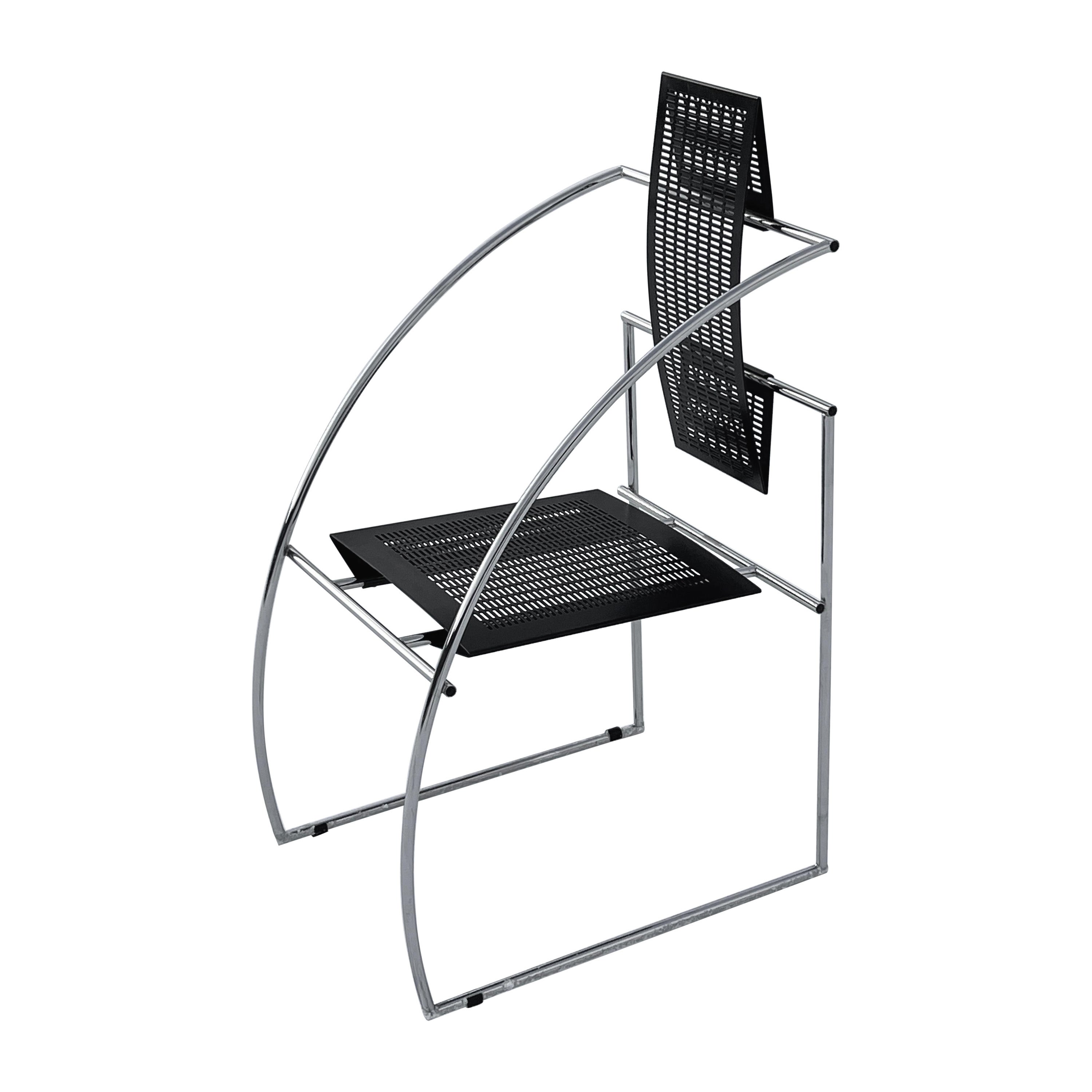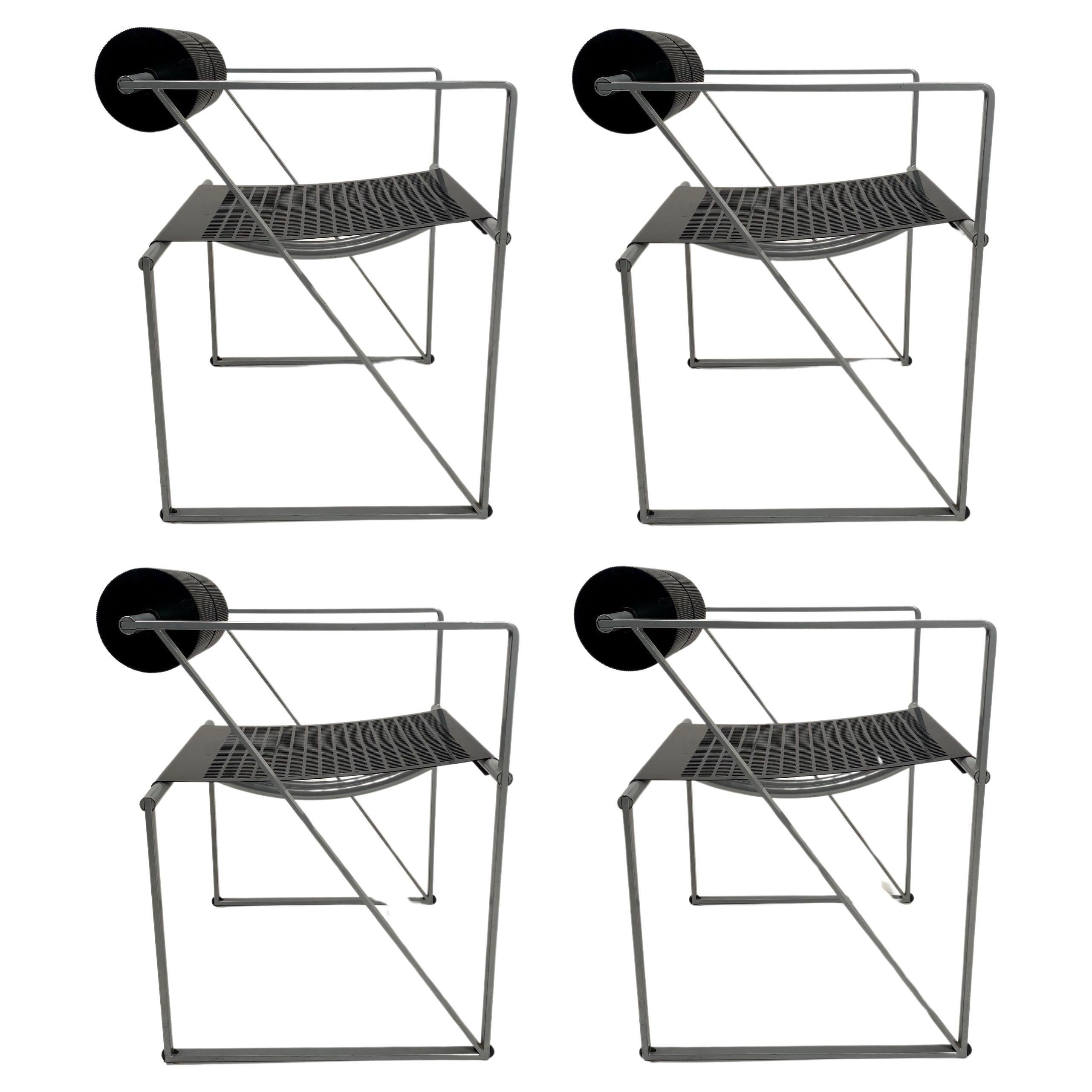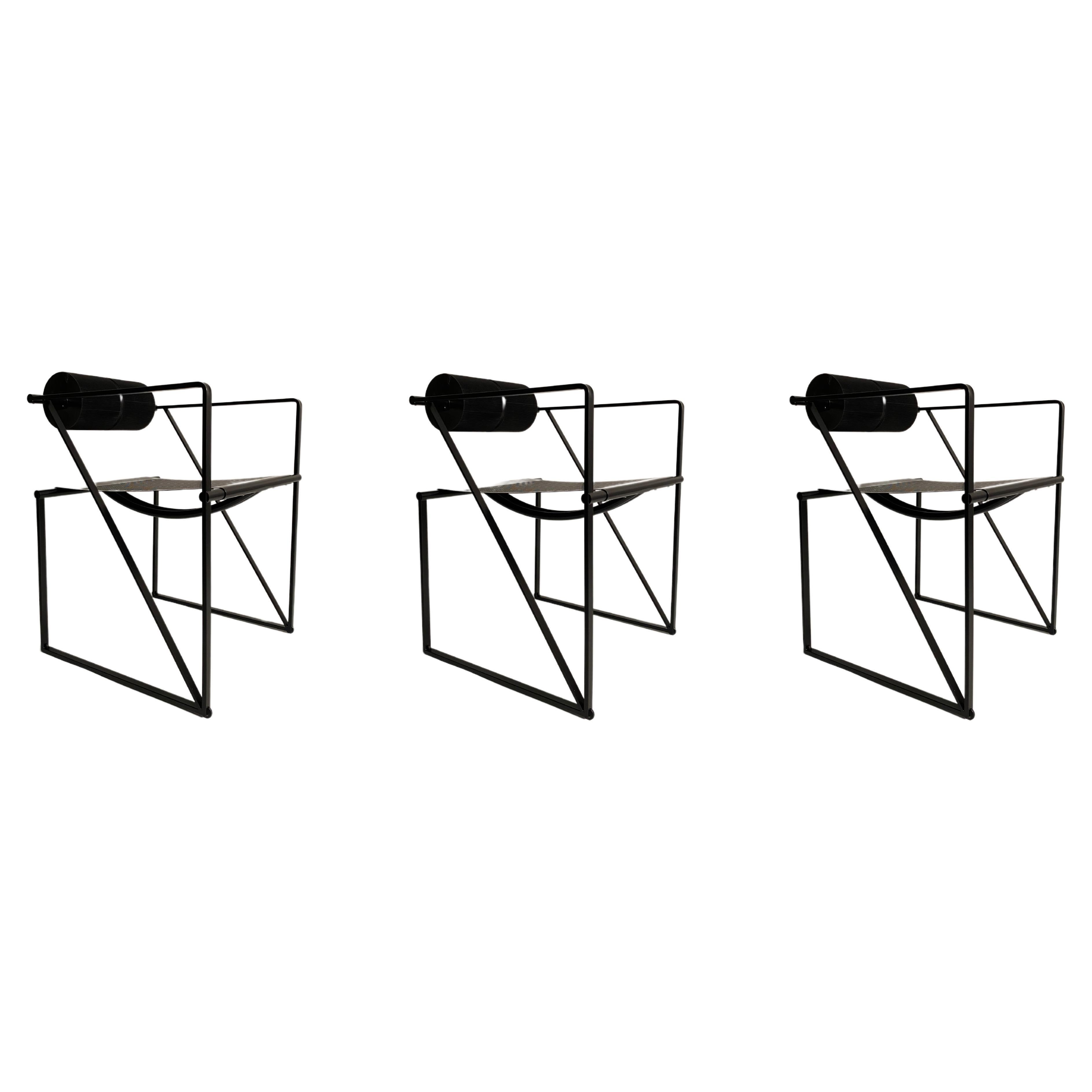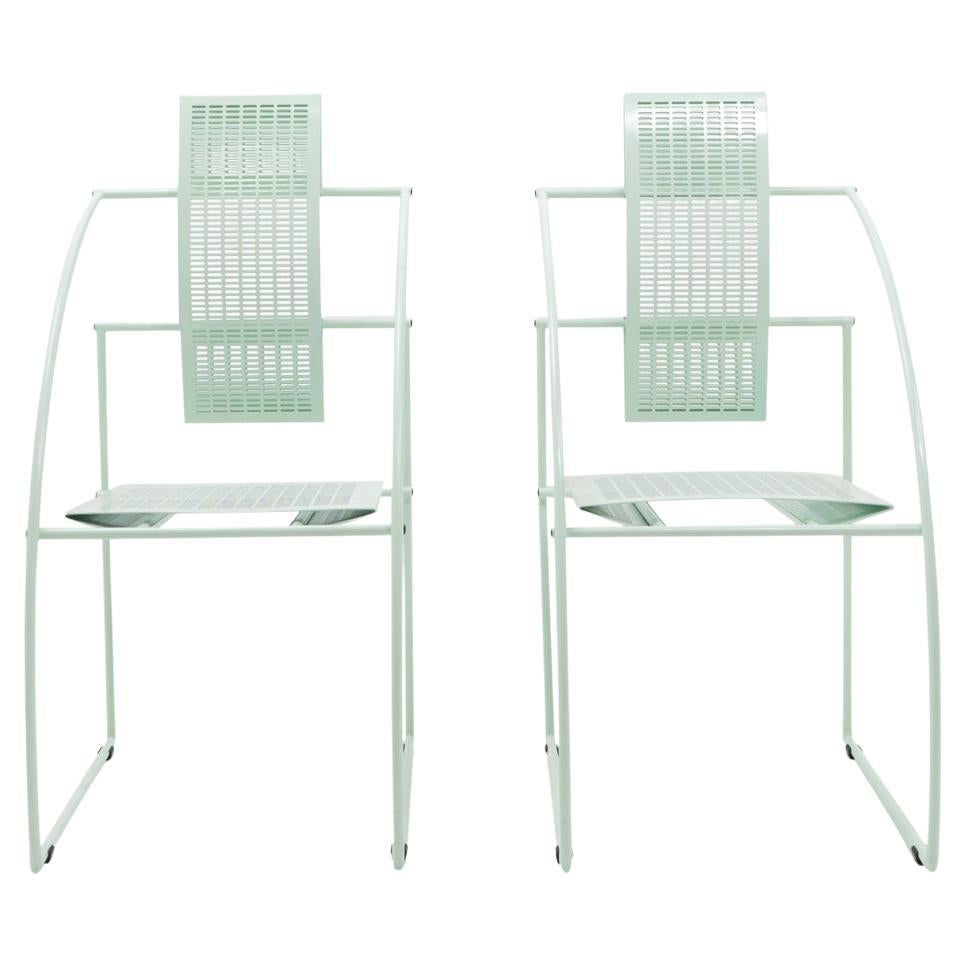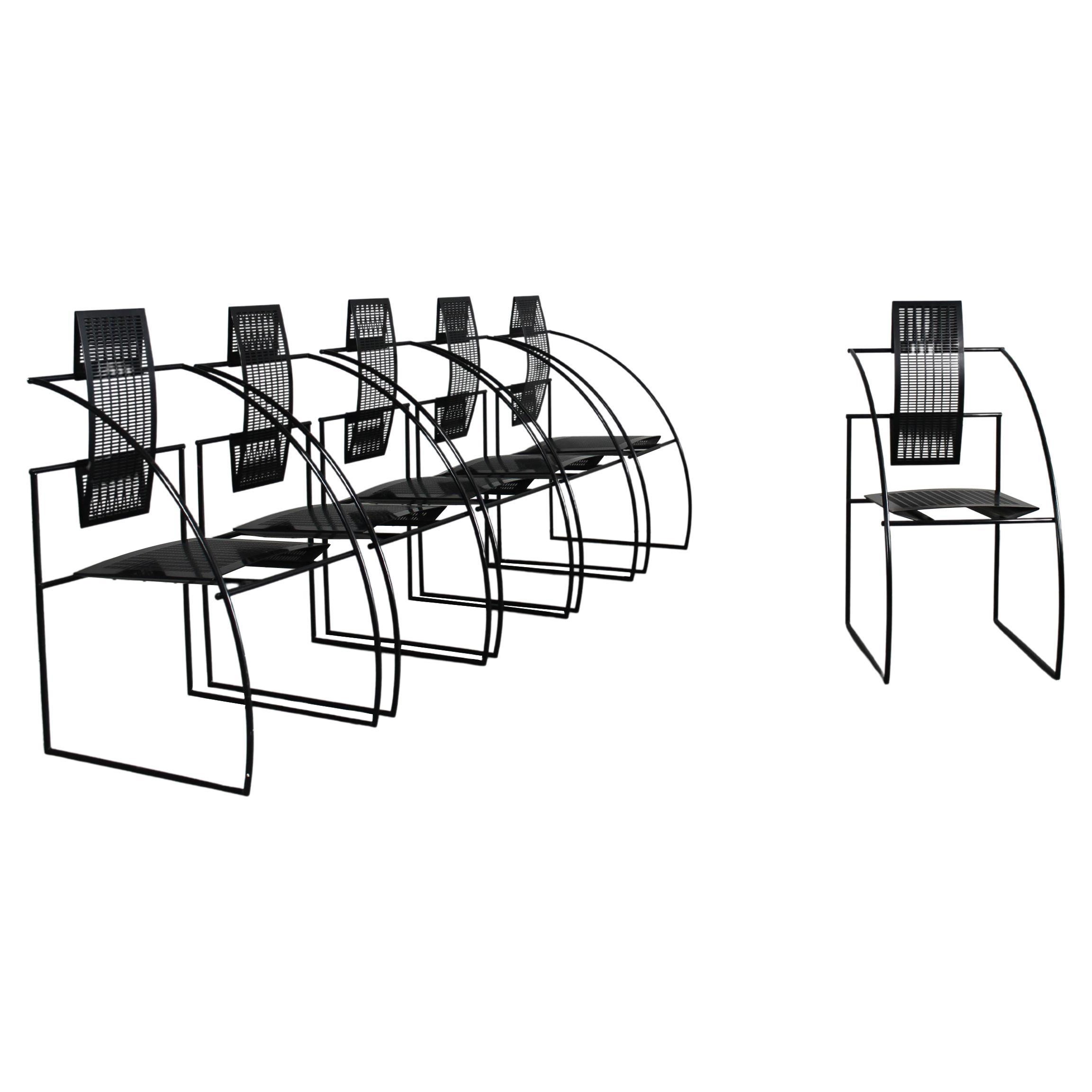Items Similar to 5 Chairs, 1980s steel and leather that might be by Mario Botta or Martin Szekely
Video Loading
Want more images or videos?
Request additional images or videos from the seller
1 of 22
5 Chairs, 1980s steel and leather that might be by Mario Botta or Martin Szekely
About the Item
Set of 5 post modern chairs in steel and leather seats, 80s.
.
Unidentified and unattributed but could be from Mario Botta or Martin Szekely, or even Philippe Starck
.
Some traces of use and the leather of the patinated seats worn in places which in no way detracts from the beauty of these pieces.
.
Dimensions :
Height : 92 cm
Width : 55 cm
Depth : 40 cm
Seat height : 48 cm
Seat depth : 39 cm
.
Each chair weighs approximately 8kgs.
.
These sublime chairs are totally in the spirit of the creations of Wilmotte, Gilles Derain, Christian Duc...
.
These pieces will match perfectly with Alvar Aalto, Charles and Ray Eames, Paul Evans, Poul Kjærholm, Florence Knoll, George Nakashima, Gio Ponti, Hans Wegner, Charlotte Perriand, Sergio Rodrigues, Eero Saarinen, Ludwig Mies van der Rohe, Harry Bertoia, Arne Jacobsen, Hans Wegner, Charles and Ray Eames, George Nelson, Warren Platner, Harry Bertoia, Isamu Noguchi, Verner Panton, Willy Rizzo, Jean Prouvé, or many others from other eras like the mid-century of the space age...
.
Please feel free to check out my other products and ask for any requests and more photos.
- Dimensions:Height: 36.23 in (92 cm)Width: 21.66 in (55 cm)Depth: 15.75 in (40 cm)Seat Height: 18.9 in (48 cm)
- Sold As:Set of 5
- Style:Post-Modern (In the Style Of)
- Materials and Techniques:
- Place of Origin:
- Period:1980-1989
- Date of Manufacture:1980
- Condition:Minor structural damages.
- Seller Location:Paris, FR
- Reference Number:1stDibs: LU7733239244052
About the Seller
5.0
Vetted Seller
These experienced sellers undergo a comprehensive evaluation by our team of in-house experts.
1stDibs seller since 2022
6 sales on 1stDibs
Typical response time: <1 hour
- ShippingRetrieving quote...Ships From: Paris, France
- Return PolicyA return for this item may be initiated within 1 day of delivery.
More From This SellerView All
- Chair that can be attributed to Paolo Pallucco & Mireille Rivier - 80s/90sBy Paolo Pallucco & Mireille RivierLocated in Paris, FROversized chair that can be attributed to Paolo Pallucco & Mireille Rivier. . Memphis period. . There is no validated attribution to date but it very closely resembles their work and...Category
Vintage 1980s Italian Chairs
MaterialsSteel, Iron
- 6 Brutalist Leather and Wood Chairs, 50s like Pierre Chapo or Charlotte PerriandLocated in Paris, FR6 french brutalist chairs in good vintage conditions . Period : 1950s. . Leather, wood and studded. . Superb patina. and veruy confortable ; s...Category
Vintage 1950s French Chairs
MaterialsLeather, Wood
- Beaubourg Chair in Steel and Fabric by Michel Cadestin and Georges LaurentBy Michel CadestinLocated in Paris, FRMichel Cadestin and Georges Laurent Beaubourg chair, 1976 Steel and fabric. . The Beaubourg chair was designed by Richard Rogers and Renzo Piano and designed especially for the Center Pompidou in Paris. . The final shape was created by Cadestin and Laurent and chosen as the winning chair for the order by a jury chaired...Category
Vintage 1970s French Chairs
MaterialsSteel
- 4 B33 MART STAM CANTILEVER CHAIRS AND 1 S34 ARMCHAIR - 80s - 1980By Mart StamLocated in Paris, FRVintage set of 4 chairs and an 1 armchair. . The tubular structure is black which is quite rare. . Mart Stam, 80s in vintage condition, Cantilever. . One of the chairs is smaller bec...Category
Vintage 1980s Swiss Chairs
MaterialsSteel
- Giovanni Offredi, Saporiti, Leather Armchair 1970s, 1980s Vintage, ItalyBy Giovanni OffrediLocated in Paris, FRRare leather lounge chair, Saporiti by Giovanni Offredi. . 1970s. . Superb patina. . Dimensions : Length : 180cm Width : 80cm Height : 68cm . The previous owner is 1m90 tall, this lounge chair will accommodate people of all sizes ??. . Giovanni Offerdi ITALIAN, 1927-2007 About his mid-century modern furniture designs, which marry minimalist simplicity with elegance and symmetry, Italian designer Giovanni Offredi once said, "Beauty should not be confused with appearance, for the latter is the superficial part of the form". Born in Milan in 1927, Offredi was not trained as an architect, unlike many of his contemporaries in the first half of the 20th century. He also didn't start designing furniture until later in his career. Its first known pieces of furniture were commissioned by wealthy Milanese families in 1960. It was not until the late 1960s - when Mr. Offredi met Sergio Saporiti, owner of Italian furniture manufacturer and design store Saporiti - that his furniture designs have become more prominent. In 1970, Offredi joined forces with Saporiti and produced several lines of innovative and modernist furniture. Among the most outstanding pieces by Offredi are the Wave chair, sofa and chaise longue, with its soft curves, the Onda coffee...Category
Vintage 1970s Italian Armchairs
MaterialsMetal
- 3 Vintage Designer Chairs Steen Ostergaard Manufacturer Cado 60sBy Steen OstergaardLocated in Paris, FR3 vintage chairs by designer Steen Ostergaard (Denmark). . Manufacturer Cado - 60s . Dimensions: . L 50 cm D 40 cm HD 75 cm HA 45 cm. . Superb patinas and rare or even unique in these colors. . Belonged to the famous designer Jean Pierre Laporte...Category
Mid-20th Century Danish Chairs
MaterialsPlastic
You May Also Like
- Mario Botta "Quinta" Chair for Alias 1980sBy Mario Botta, AliasLocated in Wien, WienQuinta, a chair with a legacy dating back to its creation in 1985, is not your ordinary seat; it embodies a fusion of comfort and architectural sophistication. Designed under the inf...Category
Mid-20th Century Italian Mid-Century Modern Chairs
MaterialsMetal, Stainless Steel
- Mario Botta, 4 'Seconda' Metal Chairs, Alias Mod. 602, 1980sBy Mario BottaLocated in Argelato, BOMario Botta, set of 4 "Seconda" Armchairs produced by Alias, Italy 1982. Structure with armrests in gray powder-coated steel, black seat in perforated steel sheet. Backrest made up...Category
Vintage 1980s Italian Post-Modern Armchairs
MaterialsSteel
- Mario Botta, 'Seconda' Black Metal Chairs, Alias Mod. 602, 1980sBy Mario BottaLocated in Argelato, BOThree 'Seconda' chairs designed by the famous architect Mario Botta for the Italian firm Alias, model 602. All three are painted black both in the structure and in the seat, they bea...Category
Vintage 1980s Italian Post-Modern Armchairs
MaterialsSteel
- Mario Botta, 4 'Seconda' Black Metal Chairs, Alias Mod. 602, 1980sBy Mario BottaLocated in Argelato, BOThree 'Seconda' chairs designed by the famous architect Mario Botta for the Italian firm Alias, model 602. All 4 are painted black both in the structure and in the seat, they bear ...Category
Vintage 1980s Italian Post-Modern Armchairs
MaterialsSteel
- Mint Green Quinta Chairs by Mario Botta for Alias, 1980sBy Mario BottaLocated in Renens, CHThe Quinta Chair is an iconic piece of design, with use of perforated sheet metal and tubing,which are typical for Botta’s furniture and lamps. The lines of these chairs are sharp, r...Category
Vintage 1980s Swiss Mid-Century Modern Chairs
MaterialsAluminum
- Mario Botta Set of Six 605 Quinta Chairs in Black Lacquered Steel by Alias 1980By Alias, Mario BottaLocated in Montecatini Terme, ITSet of six 605 Quinta chairs with a black steel rod frame seat and back in bent perforated sheet metal. Designed by Mario Botta for Alias in 1985 (This chair is no longer in production). The Quinta chair it's an architecture you can sit on, this design clearly shows the inspiration of iconic designer as Le Corbusier, Louis Kahn, and Carlo Scarpa, an exemplary of this iconic chair is also exhibited at the Museum of Modern Art. Mario Botta was born in 1943 in Mendrisio. After working as an apprentice draughtsman for the Lugano-based architect Tita Carloni, he moved first to Milan and then to Venice, where he enrolled at the department of Architecture at the IUAV. He completed his degree in 1969 with a thesis tutored by Carlo Scarpa – after having met Le Corbusier and Louis Kahn, who were later to be sources of inspiration – and returned to Switzerland to open his own professional firm, which at the time dealt mainly with detached family private homes. These included the villas in Riva San Vitale (1971-1973), Ligornetto (1975-1976) and Morbio Superiore (1982-1983), in which Botta treated the theme of the home as a refuge, which protects and reassures its inhabitants. These were buildings with a character that was ironic and, in a certain sense, monumental, obtained for example (in the case of Morbio) through rigorous symmetrical compositions and a particular use of raw concrete blocks set in a linear pattern and alternated with strips of silvered brick which, on the contrary, were set at 45 degrees. Partially dug into the hillside, the villa was also characterised by a theme which was particularly dear to Botta and which had already been explored in Riva San Vitale; the net distinction between solids and voids, the latter appearing to have been dug out of the building. Between 1980 and 1990, Botta associated with artists and intellectuals from all walks of life and took numerous long trips abroad. Together with Gabriele Basilico and Edoardo Sanguinetti, he published “La Casa Rotonda”, and he became friends with Max Huber, Nicki de Saint Phalle, Dante Isella, Harld Szeemann, Robert Frank and Alberto Flammer. In 1986, the MoMA in New York dedicated a solo exhibition to his work, and the Swiss architect received his first contracts for public buildings and from abroad, debuting with the Cultural Centre in Chambéry (1984-1987). In Japan, on a challenging triangular lot of only one hundred and sixty square metres, a space which remained from the opening of a new highway, Botta built a small building which, with its clarity and strength of image, attempted to stand out in the midst of the chaos that surrounded it, thanks to a thick masonry curtain raised on the main façade, in which slabs of grey marble are crossed with horizontal fissures which erode the angles and cancel the perception of the number of floors which make up the museum. The church of Mongo, on the other hand, was the first step in a long series of places of worship, including designs for the churches of Pordenone (1987-1992) and Sartiana (1987-1995), for the cathedral of Evry (1988-1995), for the basilica of Santa Maria degli Angeli on Mont Tamaro (1990-1996, for the Giovanni XXII church in Seriate (1994-2000) and for the Cymbalista synagogue in Tel Aviv (1996-1998). In each of these, light plays a predominant role as a prime generator of space and a measure for the definition of time that passes with the various phases of the day, the months and the seasons. Light is, however, the main symbolic element, representing through its variations the uneasiness of humankind in the face of divine perfection. In this same period, the scheduling for the construction of a new School of Architecture, the Mendrisio Academy, took place. Inaugurated in 1996, it offered an alternative approach to teaching in contrast to the Swiss University system, in which an important role is played by humanistic subjects and by a copious group of well-known international professors: from Rykwert to Benevolo, Burkhart, Campos Baeza, Dal Co, Frampton, Mendes da Rocha...Category
Vintage 1980s Italian Post-Modern Chairs
MaterialsSteel, Sheet Metal
Recently Viewed
View AllMore Ways To Browse
Poul Kjaerholm Set
Leather Chairs 1980s
Prouve Perriand
Vintage 80s Chair
Worn Leather Chairs
Prouve Chair
Charlotte Perriand Leather Chairs
5 Way Chair
Aalto Seat
Jean Prouve Chair
Gio Ponti Leather
Sergio Leather Chairs
Knoll Chair 1980
Bertoia Chair Used
Jean Prouve Chair Vintage
Philippe Starck Used
Set Of 5 Leather Chairs
Hans Wegner Steel Chair
